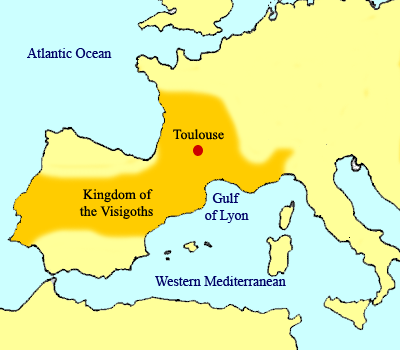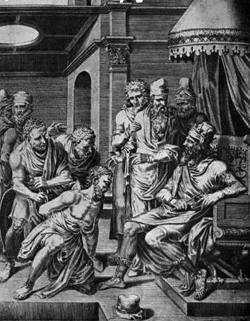
![]() The
Goths were a Germanic tribe - conveniently divided into
two main groups the Ostrogoths ("Eastern Goths")
and the Visigoths ("Western Goths")
The
Goths were a Germanic tribe - conveniently divided into
two main groups the Ostrogoths ("Eastern Goths")
and the Visigoths ("Western Goths")

![]() The
Visigoths, or Wisigoths, challenged the newly Christianised
Roman Empire with considerable success. Contrary to popular
history (written by those sympathetic to the Roman Empire
and swallowed unthinkingly for generations of readers) the
Visigoths, like other so-called barbarians were at least
as civilised as the Romans.
The
Visigoths, or Wisigoths, challenged the newly Christianised
Roman Empire with considerable success. Contrary to popular
history (written by those sympathetic to the Roman Empire
and swallowed unthinkingly for generations of readers) the
Visigoths, like other so-called barbarians were at least
as civilised as the Romans.
|
The Visigoths or Wisigoths belonged to the Arian Christian tradition so they were never entirely comfortable with Christianised Roman Empire. The Emperor, Theodosius I , had made peace with the Wisigoth leader Fritigern in 379. This peace held until Theodosius died in 395 succeeded by his two incompetent sons. In the same year, the Alaric was elected leader of the Visigoths. Over the next 15 years, conflicts alternated with periods of uneasy peace. When the western General Stilicho was murdered by the Emperor Honorius in 408, Roman legions massacred the families of 30,000 "barbarian" soldiers serving in the Roman army. Alaric declared war. With his army at the gates of Rome, Honorius declined to come to terms. Alaric sacked the city on 24th August 410. From 407 to 409 the Vandals, Alans and Germanic tribes like the Suevi had swept into Roman Hispania. In response to this invasion Honorius now enlisted the aid of the Visigoths to regain control of the Iberian peninsula. In 418, Honorius rewarded his Visigothic federates by giving them land in Gallia Aquitania on which to settle. This settlement formed the nucleus of the future Visigothic kingdom that would eventually expand across the Pyrenees. |
Visigothic Rulers Athanaric (369–381) |

![]() The
Visigoths' second great king, Euric, unified factions among
the Visigoths and in 475 forced the Roman government to
grant them full independence. At Euric's death, the Visigoths
were the most powerful of the successor states to the Western
Roman Empire.
The
Visigoths' second great king, Euric, unified factions among
the Visigoths and in 475 forced the Roman government to
grant them full independence. At Euric's death, the Visigoths
were the most powerful of the successor states to the Western
Roman Empire.
The Visigoths also became the dominant power in the Iberian Peninsula, crushing the Alans and forcing the Vandals into north Africa. By 500, the Visigothic Kingdom, centred at Toulouse, controlled Aquitania and Gallia Narbonensis and most of Hispania with the exception of the Suevic kingdom in the northwest, small areas controlled by the Basques and the southern Mediterranean coast (a Byzantine province).
Alaric II, also known as Alarik, Alarich, and Alarico in Spanish and Portuguese or Alaricus in Latin (d. 507) succeeded his father Euric in 485 as eighth king of the Visigoths. His dominions covered the whole of the Iberian Peninsular except its north-western corner along with Gallia Aquitania and the greater part of Gallia Narbonensis.
| In 486 Alaric II denied refuge to Afranius
Syagrius, the former ruler of the Domain of Soissons
who was defeated by Clovis I. Alarmed by a summons from
Clovis, Alaric imprisoned and repatriated Syagrius back
to Clovis I, where he was decapitated. This turned out
to be a strategic error.
Alaric was a Christian of the Arian variety like all the early Visigothic nobles. He was tolerant of the Catholics and authorised them to hold the council of Agde in 506. He was on uneasy terms with the Catholic bishops of Arles as epitomised in the career of the Frankish Caesarius, bishop of Arles, born at Châlons and appointed bishop in 503. Caesarius was suspected of conspiring with the Burgundians to turn over the area to Burgundy, whose king had married the sister of Clovis. Alaric exiled him for a year safely at Bordeaux in Aquitania before allowing him to return unharmed when the crisis had passed. He displayed similar wisdom and liberality in political affairs by appointing a commission to prepare an abstract of the Roman laws and imperial decrees, which should form the authoritative code for his Roman subjects. This is generally known as the Breviarium Alaricianum or Breviary of Alaric. |
|

 Alaric
tried to maintain the treaty that his father had concluded
with the Franks. The Frankish king Clovis I, a Roman Catholic,
wanted to obtain the Gothic province in Gaul and he found
a pretext for war in the Arian Christianity of Alaric. The
intervention of Theodoric, king of the Ostrogoths and father-in-law
of Alaric, failed to save him. The two armies met in 507
at the Battle of Vouillé, near Poitiers, where the
Goths were defeated and their king, who took to flight,
was overtaken and killed, apparently, by Clovis himself.
The Visigoths lost all their possessions in Gaul to the
Franks, except Septimania (i.e. the western region of Gallia
Narbonensis, which included Arles and Provence). Alaric
was succeeded by his illegitimate son, Gesalec, his legitimate
son Amalaric still being a child.
Alaric
tried to maintain the treaty that his father had concluded
with the Franks. The Frankish king Clovis I, a Roman Catholic,
wanted to obtain the Gothic province in Gaul and he found
a pretext for war in the Arian Christianity of Alaric. The
intervention of Theodoric, king of the Ostrogoths and father-in-law
of Alaric, failed to save him. The two armies met in 507
at the Battle of Vouillé, near Poitiers, where the
Goths were defeated and their king, who took to flight,
was overtaken and killed, apparently, by Clovis himself.
The Visigoths lost all their possessions in Gaul to the
Franks, except Septimania (i.e. the western region of Gallia
Narbonensis, which included Arles and Provence). Alaric
was succeeded by his illegitimate son, Gesalec, his legitimate
son Amalaric still being a child.
By the eighth century the Moors
had pushed up from the south and established themselves
north of the Pyrenees
( Pirenčus,
Pirenčus,
 Pirineus,
Pirineus,
 Pyrénées).
Pyrénées).

 The
Visigoths occupation left few traces. Among them are objects
such as belt buckles, bronze artifacts and glassware. Another
reminder is place names, including many ending in ens
(such as Pezens, Couffoulens, and Sauzens). In the Aude
département there is even a mountain named after
King Alaric, who, curiously, is still remembered locally,
after more than a millennium, with respect and affection.
The
Visigoths occupation left few traces. Among them are objects
such as belt buckles, bronze artifacts and glassware. Another
reminder is place names, including many ending in ens
(such as Pezens, Couffoulens, and Sauzens). In the Aude
département there is even a mountain named after
King Alaric, who, curiously, is still remembered locally,
after more than a millennium, with respect and affection.







